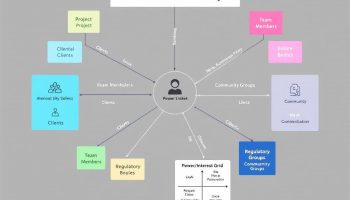
Organizational change and change management create a structured approach to move individuals, teams, and organizations from their current position to a desired future state. The seven-step framework offers a comprehensive roadmap to implement changes effectively while reducing resistance and boosting adoption across all organizational levels.
Why Effective Change Management Is Critical for Business Success
Organizational change and change management are vital for businesses in today’s fast-paced marketplace. Without a systematic approach, transformation initiatives typically fail, resulting in wasted resources, lower morale, and missed opportunities. Companies that master change management can adapt quicker to market shifts, integrate new technologies smoothly, and keep their competitive edge.
The seven-step process—from readiness assessment through sustaining changes—addresses both technical and human aspects of transformation, creating lasting results instead of temporary fixes. This change management approach helps your business handle complex changes while maintaining productivity and employee engagement throughout the process.
Following this structured methodology allows you to anticipate resistance points, prepare stakeholders adequately, and measure success at each implementation stage. Proper change management reduces disruption costs and accelerates the timeline to realize benefits from organizational changes.
Organizational Change and Change Management
Organizational change and change management are fundamental to business success in today’s fast-paced environment. Companies that master these processes can adapt swiftly to new market conditions while maintaining productivity and employee engagement. The seven-step approach to change management offers a practical framework that addresses both the technical and human aspects of transformation.
Proper planning becomes your strongest asset when implementing organizational change. Starting with thorough readiness assessments helps identify potential obstacles before they derail your initiative. Each progressive step in the change management process builds on previous ones, creating a solid foundation for lasting transformation.
Resistance to change is natural, but it doesn’t have to derail your efforts. By following a structured methodology, you can anticipate concerns, allocate appropriate resources, and establish clear metrics to track progress. Change leaders who excel at communicating the vision behind organizational changes achieve higher adoption rates.
1. Conduct a Change Readiness Assessment
Effective organizational change and change management begins with a thorough readiness assessment. You need to evaluate your current organizational state to understand the starting point before implementing any changes. This assessment helps identify potential barriers and risks that might impede your change initiative’s success.
Begin by analyzing your company’s previous experiences with organizational change and change management efforts. Document what worked well and what challenges arose. Next, assess resource availability—including budget, technology, and personnel—to ensure you have the necessary support for implementation.
Survey employee readiness through:
- Anonymous questionnaires about attitudes toward change
- Focus groups with representatives from different departments
- One-on-one interviews with key stakeholders
- Assessment of current workloads and capacity for additional responsibilities
The insights gathered during this phase will form the foundation of your strategic planning for change. By understanding your organization’s readiness level, you can tailor your approach to address specific concerns and leverage existing strengths, significantly increasing your chances of successful implementation.
2. Create a Clear Vision and Strategy
Effective organizational change and change management requires a well-defined vision that serves as your north star throughout the transformation journey. When establishing your change strategy, begin by defining specific objectives that address the core reasons for implementing change. Your success metrics should be measurable and directly tied to these objectives, allowing you to track progress and demonstrate value.
Developing a comprehensive implementation timeline helps create structure for your organizational change initiatives. Consider breaking down the timeline into phases with specific milestones to make the process more manageable. This approach allows you to:
- Identify critical dependencies between activities
- Allocate resources appropriately across the timeline
- Create natural checkpoints for reviewing progress
- Adjust strategies based on real-time feedback
Most importantly, ensure your change vision aligns with broader organizational goals. This alignment is crucial for securing stakeholder support and demonstrating how the change contributes to the company’s strategic direction. When employees understand how change management connects to the organization’s future success, they’re more likely to embrace the transformation process.
Expert Insight: To drive effective organizational change, clearly articulate a vision tied to specific objectives and measurable success metrics. Develop a structured implementation timeline with phases and milestones, ensuring alignment with broader organizational goals to secure stakeholder support. Engage employees by connecting the transformation to the company’s future success.
3. Build a Strong Change Management Team
Effective organizational change and change management requires a dedicated team of professionals who can guide the transformation process. Start by identifying key stakeholders who have influence within your organization and can champion the change initiative. These individuals should represent various levels of authority and departments affected by the change.
Assign clear roles and responsibilities to each team member to prevent confusion and ensure accountability throughout the process. Your change management team should include:
- Executive sponsor to provide resources and remove obstacles
- Change manager to oversee day-to-day implementation
- Department representatives to address specific operational concerns
- HR personnel to manage people-related impacts
Select change ambassadors across departments who can serve as the voice of the change at the ground level. These individuals should be respected by their peers and possess strong communication skills to effectively relay messages.
Establish a governance structure that outlines decision-making protocols, escalation paths, and reporting requirements. This framework will help maintain control during periods of uncertainty and ensure organizational change initiatives stay on track despite inevitable challenges.
Expert Insight: To successfully implement change, form a dedicated change management team with clearly defined roles. Include key stakeholders, change ambassadors, and a governance structure to ensure accountability and effective communication. This approach fosters collaboration and helps navigate challenges while maintaining focus on the transformation objectives.
4. Develop a Comprehensive Communication Plan
Effective organizational change and change management requires a robust communication strategy that keeps everyone informed and engaged. When developing your communication plan, start by creating targeted messages that resonate with different stakeholder groups. Consider how each audience will be affected by the change and customize your messaging accordingly.
Schedule regular updates throughout the change process to maintain transparency and build trust. These touchpoints should include:
- Kickoff announcements explaining the “why” behind changes
- Weekly progress updates via team meetings
- Monthly town halls for broader organizational updates
- One-on-one check-ins with those most impacted
Select the most appropriate communication channels based on message urgency and audience preferences. Effective project communication might include email for formal announcements, intranet posts for reference materials, and video conferences for interactive discussions.
Plan for two-way feedback mechanisms that allow employees to voice concerns and ask questions. This bidirectional approach helps identify resistance early and demonstrates that you value input. Consider implementing anonymous suggestion boxes, regular pulse surveys, and dedicated Q&A sessions to gather insights that can improve your change management approach.
Expert Insight: Develop a comprehensive communication plan that targets diverse stakeholder groups with tailored messages about organizational change. Schedule regular updates to maintain transparency and trust, and implement two-way feedback mechanisms to address concerns. This approach fosters engagement and ensures a smoother transition during the change process.
5. Implement Training and Support Systems
Effective organizational change and change management requires comprehensive training programs tailored to different roles within your company. Begin by identifying knowledge gaps to develop targeted learning experiences that address specific needs.
When implementing organizational change, ensure your training covers both technical skills and the emotional aspects of adapting to new processes. Create accessible support documentation that employees can reference during the transition phase. This documentation should include step-by-step guides, frequently asked questions, and troubleshooting tips.
Consider these support mechanisms to facilitate change:
- A dedicated help desk staffed with knowledgeable team members
- Peer mentoring programs where early adopters support colleagues
- Digital learning platforms with on-demand resources
- Regular check-in sessions to address emerging challenges
Your communication strategy during change should emphasize that training is an ongoing process rather than a one-time event. Allocate sufficient resources to maintain support systems throughout the implementation phase and beyond, ensuring sustainable adoption of new practices.
Expert Insight: Implementing effective training and support systems is crucial for successful organizational change. Identify knowledge gaps to create tailored learning experiences, and provide comprehensive resources, including help desks and mentoring programs. Emphasize ongoing training as a continuous process, ensuring sustained adoption of new practices throughout the transition.
6. Execute the Change Initiative Through Phased Implementation
Effective organizational change and change management requires a methodical implementation approach. Begin by rolling out changes in carefully planned phases to prevent overwhelming your team and organization. Each phase should follow the key phases of project implementation while maintaining alignment with your overall change strategy.
Monitor progress continuously against your predefined metrics to ensure the organizational change is proceeding as planned. This allows you to identify deviations early and make necessary adjustments. When implementing complex changes, consider using a RACI model to clarify decision-making authority and responsibilities throughout the process.
Address resistance promptly when it emerges by:
- Listening actively to concerns
- Providing additional information or training
- Involving resistant individuals in problem-solving
- Reinforcing the benefits of the change
Remain flexible and adjust your plans based on stakeholder feedback. Use a structured action log to track implementation issues and ensure proper follow-up. Remember that successful change management requires both adherence to the plan and willingness to adapt when circumstances require it.
7. Sustain and Reinforce Organizational Change
The final step in effective organizational change and change management involves creating mechanisms to sustain momentum and reinforce new behaviors. Celebrating quick wins demonstrates the value of change efforts and boosts morale during transition periods. When team members see positive results from their adaptation to new processes, their commitment to continued change strengthens.
Document lessons learned throughout the change process to build your organizational knowledge base. This documentation serves as valuable reference material for future change initiatives and helps continuous improvement efforts within your organization.
To ensure lasting adoption, integrate changes into regular operations by:
- Updating standard operating procedures to reflect new processes
- Revising performance metrics to align with changed behaviors
- Incorporating new practices into onboarding materials
- Adjusting job descriptions to reflect modified responsibilities
Conduct post-implementation reviews to monitor long-term adoption patterns and identify areas requiring additional support. Track key performance indicators related to the change objectives to measure ongoing success and prevent regression to previous practices.

Organizational change and change management is a structured approach to transitioning individuals, teams, and organizations from their current state to a desired future state. The seven-step framework outlined in this article provides a comprehensive roadmap for implementing successful organizational transformations, from conducting readiness assessments to sustaining long-term adoption of new processes and behaviors.
Organizational change and change management is essential for businesses facing evolving market conditions, technological advancements, and shifting customer expectations. Companies that master these processes gain competitive advantages through increased adaptability, improved operational efficiency, and enhanced employee engagement, while those that fail to effectively manage transitions risk decreased productivity, talent loss, and ultimately, business failure in today’s rapidly changing business landscape.
Key Takeaways from the Change Management Process
Successful organizational change requires a systematic approach that addresses both strategic planning and human elements. The seven-step methodology provides a comprehensive framework for navigating complex transformations while minimizing resistance and maximizing adoption.
| Step | Key Components | Benefits |
|---|---|---|
| 1. Readiness Assessment | Evaluate current state, identify barriers | Creates foundation for strategic planning |
| 2. Vision & Strategy | Define objectives, create timeline | Provides direction and measurable goals |
| 3. Change Team | Assign roles, establish governance | Ensures accountability and leadership |
| 4. Communication Plan | Target messages, gather feedback | Builds trust and engagement |
| 5. Training & Support | Address knowledge gaps, provide resources | Facilitates skill development |
| 6. Phased Implementation | Monitor progress, adjust as needed | Prevents overwhelming stakeholders |
| 7. Reinforcement | Celebrate wins, integrate into operations | Sustains long-term adoption |
Essential Steps for Implementing Organizational Change
- Conduct a thorough readiness assessment by surveying employees and analyzing previous change experiences
- Develop a clear vision with specific objectives and measurable success metrics aligned with organizational goals
- Assemble a change management team with diverse representation and clearly defined roles
- Create a comprehensive communication plan with targeted messaging for different stakeholder groups
- Implement tailored training programs addressing both technical skills and emotional aspects of change
- Execute changes in manageable phases while continuously monitoring progress
- Document lessons learned and integrate changes into standard operating procedures
- Establish feedback mechanisms to identify and address resistance promptly
- Celebrate quick wins to demonstrate value and maintain momentum
- Conduct post-implementation reviews to ensure sustained adoption
Frequently Asked Questions About Organizational Change
- What is the difference between organizational change and change management? Organizational change refers to the actual transition from current to future state, while change management is the structured approach used to guide people through the transition, addressing the human side of change including communication, training, and addressing resistance.
- How long does a typical organizational change initiative take? The timeline varies significantly based on the scope and complexity of the change, but most substantial organizational changes require 6-18 months for full implementation and adoption, with larger enterprise-wide transformations potentially taking several years.
- What’s the biggest reason organizational change initiatives fail? Most change initiatives fail due to inadequate communication and insufficient attention to the human elements of change, including resistance management, proper training, and addressing employee concerns throughout the process.
- How can we measure the success of our change management efforts? Success can be measured through predefined KPIs tied to your change objectives, adoption rates of new processes, employee feedback surveys, productivity metrics, and comparison of business outcomes before and after implementation.
- How do we address resistance to change within our organization? Address resistance by listening actively to concerns, providing transparent information about the reasons for change, involving resistant individuals in problem-solving, offering adequate training and support, and clearly communicating benefits of the change.
- What role should leadership play in organizational change? Leaders should visibly champion the change, communicate its importance and benefits consistently, model desired behaviors, allocate necessary resources, remove obstacles, and recognize progress throughout the transformation process.






